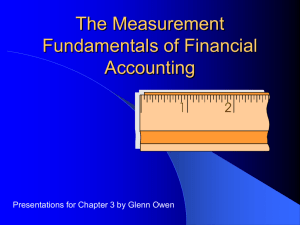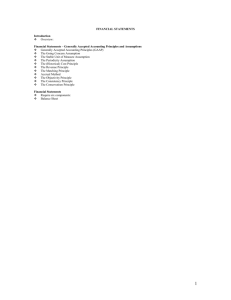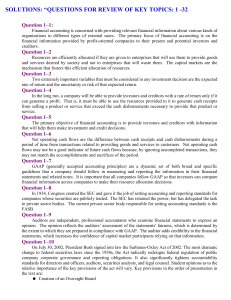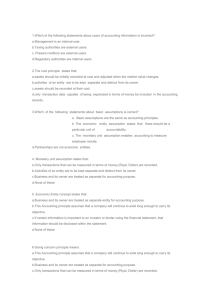CHAPTER 3
advertisement
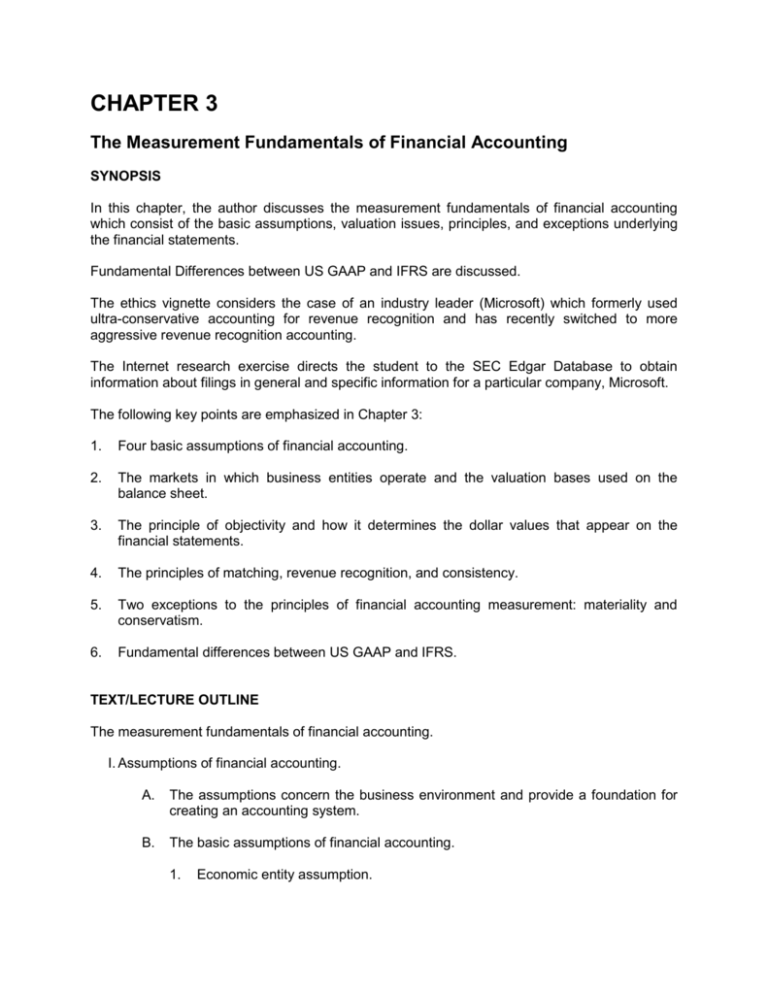
CHAPTER 3 The Measurement Fundamentals of Financial Accounting SYNOPSIS In this chapter, the author discusses the measurement fundamentals of financial accounting which consist of the basic assumptions, valuation issues, principles, and exceptions underlying the financial statements. Fundamental Differences between US GAAP and IFRS are discussed. The ethics vignette considers the case of an industry leader (Microsoft) which formerly used ultra-conservative accounting for revenue recognition and has recently switched to more aggressive revenue recognition accounting. The Internet research exercise directs the student to the SEC Edgar Database to obtain information about filings in general and specific information for a particular company, Microsoft. The following key points are emphasized in Chapter 3: 1. Four basic assumptions of financial accounting. 2. The markets in which business entities operate and the valuation bases used on the balance sheet. 3. The principle of objectivity and how it determines the dollar values that appear on the financial statements. 4. The principles of matching, revenue recognition, and consistency. 5. Two exceptions to the principles of financial accounting measurement: materiality and conservatism. 6. Fundamental differences between US GAAP and IFRS. TEXT/LECTURE OUTLINE The measurement fundamentals of financial accounting. I. Assumptions of financial accounting. A. The assumptions concern the business environment and provide a foundation for creating an accounting system. B. The basic assumptions of financial accounting. 1. Economic entity assumption. Chapter 3 2. 3. 4. II. a) Investors are interested in obtaining information about a particular profitseeking entity. Consequently, the economic activities of that entity must be able to be identified and separated from the economic activities of its owners and all other entities. b) Economic units versus legal units. Fiscal period assumption. a) The life of the entity can be broken into arbitrary time periods (fiscal periods) over which its performance and financial position can be measured. b) This assumption is necessary to provide timely performance measures to investors. However, there is a tradeoff between timely and objective financial information. Going concern assumption. a) The life of the economic entity is assumed to extend indefinitely beyond the current fiscal period. b) This assumption allows accountants to adhere to accrual accounting and to record assets and liabilities. Stable dollar assumption. a) An entity's performance and financial position is measured in monetary units. The monetary unit is assumed to possess stable purchasing power over time. b) The assumption is inconsistent with the reality of inflation. Consequently, this assumption leads to financial statements that "distort" a company's actual performance. Valuations on the balance sheet. A. Four valuation bases to use in measuring an entity's performance and financial position. 1. Present value—represents the discounted future cash flows associated with a particular financial statement item. 2. Fair market value—represents the sales value in the output market. 3. Replacement cost—represents the current prices paid in the input market. 4. Original cost—represents the input price paid when originally purchased by the company. III. The principles of financial accounting measurement. Chapter 3 A. B. Principle of objectivity. 1. Financial accounting information must be verifiable and reliable. The value of a transaction (and the assets and liabilities arising from that transaction) must be objectively determined; individuals with conflicting incentives would agree on the value of the transaction. 2. Evaluation of present value, fair market value, and original cost on the dimension of objectivity. 3. Requirement for objective measures excludes items of value, such as accrued goodwill, from an entity's financial statements. Matching principle. 1. Costs are matched against the benefits that result from them. 2. The first step in applying the matching principle is deciding when to recognize the benefit (i.e., revenue). C. Principle of revenue recognition. 1. Addresses the question of when to recognize revenue. 2. Criteria for recognizing revenue. a) The company must have completed a significant portion of the production and sales effort. b) The amount of revenue can be objectively measured. c) The major portion of the costs has been incurred and the remaining costs can be reasonably estimated. d) The eventual collection of cash is reasonably assured. D. Principle of consistency. 1. Consistency refers to the use of the same accounting policies over time. 2. GAAP encourages a company to use the same accounting policies to promote comparability of a company's performance over time. 3. Accounting methods can and do change from time to time. IV. Two exceptions to the basic principles. A. Materiality. Chapter 3 B. 1. If the cost of providing financial information to investors exceeds the expected benefit they would derive from the information, then the company may record the event in the least costly method. In other words, an event is immaterial if the way in which it is recorded would not affect investors' evaluation and control decisions. 2. Applying materiality requires a great deal of judgment. Conservatism. Conservatism states that, when in doubt, financial statements should understate assets, overstate liabilities, accelerate the recognition of losses, and delay the recognition of gains; when there is significant uncertainty about a transaction’s value, the conservative alternative should be chosen. V. International perspective: Fundamental differences between US GAAP and IFRS VI. Ethics in the real world. VII. Internet research exercise. LECTURE TIPS 1. It is important to tie the principles and assumptions back into the objective of financial accounting and to illustrate how the principles and assumptions affect accounting procedures. A highly recommended approach is to have students evaluate different companies using financial statements based on different assumptions and valuation bases. 2. The use of illustrative cases may make it easier for students to understand the specific principles and assumptions. ANSWERS TO IN-TEXT DISCUSSION QUESTIONS 80. Each of the various businesses within Fortune Brands are companies within a company and have distinct needs to report separate measures of performance and financial position for any number of management, credit, tax, and regulatory purposes. Most firms operate with some degree of integration, so it may be difficult to account for transactions between the various businesses and to account for corporate costs and assets common to all members of the consolidated group. 80. There is a trade-off between the timeliness of accounting information and its objectivity and credibility. Certain accounting information becomes less reliable and more prone to error because more arbitrary and subjective as the reporting period becomes shorter, and it has not yet been subjected to independent verification. Timeliness is often more important than precision to managers. 81. Going concern is a fundamental assumption underlying our accounting model which uses historical costs as a valuation basis and classifies assets and liabilities and current and long-term. In making an evaluation of going concern status, auditors consider numerous factors such as negative trends (recurring operating losses, capital deficiencies, adverse financial ratios), other indicators of possible financial difficulties (default on loan Chapter 3 agreements), and internal and external matters (labor difficulties, loss of a key customer or supplier). Not being able to obtain needed financing negatively impacts the businesses' prospects for remaining in business over the short term. Auditors are concerned with the viability of a business as a going concern, because if a company were not expected to stay in business beyond the current year, then liquidation values would be a more appropriate valuation basis, and current and long-term classifications would be meaningless. 82. Johnson & Johnson’s claim of a 5 percent increase in sales is legitimate because of the stable dollar assumption. 83. Financial statements are prepared on the stable dollar assumption, which assumes that the purchasing power of the dollar remains constant across fiscal periods, ie, no inflation. If inflation was significant to J.C. Penney, a user of the financial statements would want to assess the degree to which the financial statements were in fact distorted because inflation is ignored in the financial statements. 84. An analyst attempting to compare companies using different currencies in their financial statements would need to convert the financial statements of one of the two companies into the currency of the other using the applicable exchange rates. This is easier said than done. 85. The $7.1 billion value reported as vehicles on Avis’s balance sheet would represent original cost to Avis, ie, the input price paid when the vehicles were originally purchased. Present value of the vehicles could be computed by projecting future cash flows from operation and ultimately disposal of the vehicles, and discounting those cash flows back to a present value using time value of money techniques. Fair market value of the vehicles would be determined by what Avis could sell the vehicles for in the output market today. Replacement cost would be the cost Avis would have to pay in today’s input market to purchase the vehicles. Original cost is useful because it is objectively measurable and verifiable. Present value involves a great deal of estimation; in concept it does indicate the true economic value to the firm of the vehicles. Fair market value and replacement cost both represent established prices in the output and input markets, respectively, which would be obtainable from buyers and sellers. Fair market value and replacement cost would be most useful if Avis planned to sell off the fleet or replace it. However, neither possibility coincides with the planned use by Avis of the vehicles. 85. Because there was no market for these assets, there was no market value. Cost is irrelevant. Management’s best estimate of the net realizable value of the assets would be more meaningful than either zero or cost. 87. The greatest dollar amount of NIKE’s assets consists of current assets – cash, short term investments, receivables and inventory. Cash is valued at face, short term investments at market, receivables at net realizable value, and inventory at the lower of cost or market. Property, plant and equipment, intangible assets and goodwill are all valued at historical cost (net of amortization or depreciation). 88. Any attempt to value intellectual property rights would be inherently subjective. An important principle of accounting measurement is the principle of objectivity, which requires that for accounting information to be reliable, it must be verifiable (ie, determined, usually in Chapter 3 an arm’s-length transaction, and backed by documentary evidence). Intellectual property rights that are purchased are valued at cost (net of amortization) but those developed internally do not appear on balance sheets. 89. The proposed new standard would use uncertain estimates of future cash flows to estimate fair value where observable market prices are not available. Such a standard has the advantage of providing economic value information consistent with an entity’s expectations of future use of the asset, but does involve complex judgments and gives imprecise results. 90. Under US GAAP the principal of objectivity demands that property, plant and equipment be recorded at historical cost. Fair market value is a subjective determination and is useful information and has not been adopted by GAAP for incorporation into the financial statements because of appraisal costs and concerns about manipulation of net income with the effects of valuation changes. Because IFRS allows the use of fair market value in certain situations for valuation for intangible assets and for property, plant and equipment, one can infer that the principle of objectivity is less important under IFRS than it is under US GAAP. 92. The change had the effect of spreading revenue over several future years rather than all in the first year when the contracts were signed, thereby reducing current income and increasing future income. Spreading the revenue is a better example of the matching process. Certainly the company will have costs in future years to service the contracts and spreading the revenues forward to those future years provides for a better matching of the cost of the efforts with the benefits. 93. The cumulative effect of such an accounting change would be shown in the year of the change as a separate line item in the income statement. Additionally, the change would be described in footnotes to the financial statements and highlighted in the auditor’s report. 94. A quantitative analysis of materiality is based solely on the size of the item in dollar terms relative to some base. The SEC noted that many companies and auditors consider 5% of income as a materiality threshold, i.e., items greater than that amount would affect the judgment of a reasonable user of the financial statements. The SEC implored companies and auditors to also consider the qualitative effect of an item, even if otherwise small. Such qualitative effects include changes in earnings or other trends, compliance with loan covenants or contractual agreements, unlawful acts, and so on.
